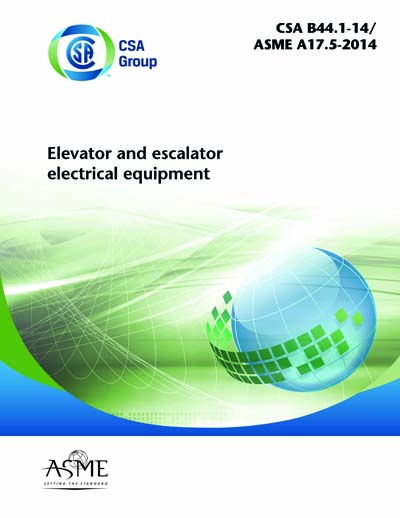Historical
CSA B44.1-2014/ASME A17.5-2014
CSA B44.1-14/ASME-A17.5-2014 - Elevator and escalator electrical equipment
Preface
This is the fifth edition of CSA B44.1/ASME A17.5, Elevator and escalator electrical equipment. It supersedes the previous editions published in 2011, 2004, 1996, and 1991. The purpose of this Standard is to reduce the risk of injury to persons and damage to property from fire and electrical shock. To this end, it is a safety Standard for the design and construction of equipment to be used in conformity with the rules of the applicable elevator and electrical codes (i.e., ASME A17.1/CSA B44 and CSA C22.1, Canadian Electrical Code, Part I, or ANSI/NFPA 70). This Standard arose from the need to have identical Canadian and U.S. requirements for this equipment, thereby enabling manufacturers to have their products certified by an approved testing laboratory in Canada or the United States and to have the certification ratified for acceptance in either country. In 1986, an ad hoc committee on the certification of electrical equipment consisting of jurisdictional authorities, representatives of Canadian and U.S. testing laboratories, and Canadian and U.S. manufacturers began to develop a draft for submission to the ASME A17 Standards Committee on Elevators and Escalators and the CSA Technical Committee on the Elevator Safety Code. Its initial investigation consisted of a review of the industrial control Standards CSA C22.2 No. 14 and UL 508. These Standards could not be used as such, due to the differences in the application of industrial control equipment and elevator equipment. It was recognized that industrial control equipment normally operates continuously for a low number of operations (about 3000/year) and at full-load current. In contrast, elevator control equipment operates intermittently for a high number of operations (about 500 000/year), and at up to 200 to 250% of full-load current in order to accelerate a mass. Further, elevator equipment is usually protected by either a locked machine room or a hoistway. The applicable portions of CSA C22.2 No. 14 and UL 508 were then reviewed and adapted to elevator equipment. (Grateful acknowledgement is made to Underwriters Laboratories Inc. for the use of UL 508.) Where there were differences between the UL and CSA Group Standards, the more stringent requirements were used. This Standard has been approved by the CSA Technical Committee on the Elevator Safety Code and the ASME A17 Standards Committee on Elevators and Escalators. It is the intent of these committees to maintain a single harmonized Standard by coordinating their procedures for revising and interpreting this Standard. To this end, interpretations and revisions of this Standard will not be issued without the approval of both committees. Changes to this edition include: (a) addition of Clause 2.3, Definitions; (b) addition of Clause 5.3; (c) update to Clause 6.4.2; (d) updates to Clause 7.1, Requirements for enclosures; (e) addition of Clause 7.2; (f) update to Clause 12.2, and addition of Clauses 12.4 and 12.5; (g) updates to Clauses 19.2.1, 19.2.2, and 19.2.3; (h) update to Clauses 20.8 and 20.11; (i) addition of Clauses 20.22, 20.23, and 20.24; and (j) updates to Table 18.Scope
1.1 The requirements of this Standard apply to the following electrical equipment for elevators, escalators, moving walks, dumbwaiters, material lifts, and elevating devices for persons with physical disabilities (platform lifts and stairway chairlifts): (a) motor controllers; (b) motion controllers; (c) operation controllers; (d) operating devices; and (e) all other electrical equipment not listed/certified and labelled/marked according to another product safety standard or code. The equipment specified in this Standard is intended for installation in accordance with the Canadian Electrical Code, Part I (CSA C22.1) and the National Electrical Code (ANSI/NFPA 70), whichever is applicable. Note: Controllers (i.e., motion, motor, and operation controllers) are defined in CSA B44 and ASME A17.1. 1.2 The electrical equipment covered by this Standard is intended (a) to be connected to supply circuits at a nominal system voltage of 600 V or less; (b) for internal voltages that are not more than 1500 V; (c) for use in non-hazardous locations in accordance with the rules of the applicable electrical codes; and (d) for use in an ambient temperature no greater than 40 °C. Note: This Standard does not include requirements for equipment intended for use in an ambient temperature above 40 °C. Additional investigation of the equipment will be required when equipment is to be used in ambient temperature above 40 °C. 1.3 The object of this Standard is to reduce the risk of injury to persons and damage to property from fire and electrical shock by presenting requirements for the proper design, the good construction, and the high quality of work of the equipment listed in Clause 1.1. 1.4 This Standard does not apply to devices that are rated for connection to extra-low-voltage Class 2 supply circuits as defined in the applicable electrical code. Note: Extra-low-voltage circuits are circuits that have a voltage of not more than 30 V rms or 42.4 V peak. 1.5 In this Standard, shall is used to express a requirement, i.e., a provision that the user is obliged to satisfy in order to comply with the standard; should is used to express a recommendation or that which is advised but not required; and may is used to express an option or that which is permissible within the limits of the standard. Notes accompanying clauses do not include requirements or alternative requirements; the purpose of a note accompanying a clause is to separate from the text explanatory or informative material. Notes to tables and figures are considered part of the table or figure and may be written as requirements. Annexes are designated normative (mandatory) or informative (nonmandatory) to define their application. 1.6 The values given in SI units are the units of record for the purposes of this Standard. The values given in parentheses are for information and comparison only.Content Provider
CSA America, Inc. [csa]






